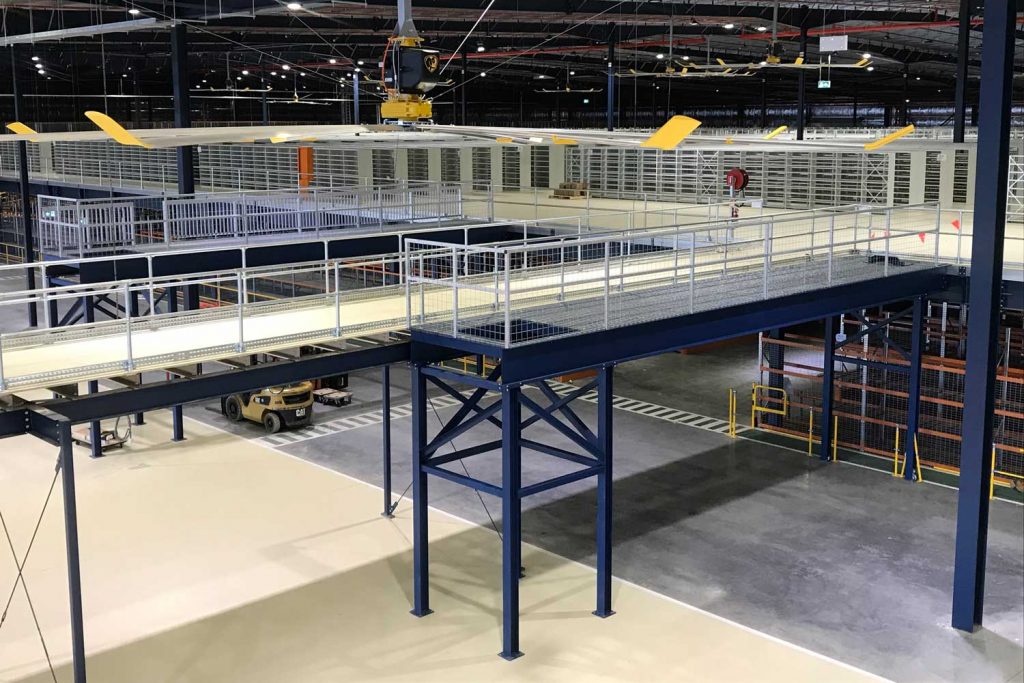How to Ensure Your Mezzanine Structure Meets Australian Standards
In this complete guide to the Australian standards for mezzanine structures, we'll cover all of the information you need to know about design, construction, installation, and compliance so you can make an informed decision and create a safe and functional space for your business.
Key Takeaways
- It's important that you comply with building standards.
- To comply with standards, you need to consider load capacity requirements, codes and safety regulations, and other important standards.
- There are different load types and weight limits for mezzanine floors depending on their intended use.
First, understand your factory or warehouse load capacity requirements
Understanding your industrial factory or warehouse load capacity requirements is a crucial first step when planning a mezzanine structure installation. It involves assessing the weight of the loads you'll be storing, understanding the load-bearing capacity of the structure, and ensuring that it meets the necessary standards for safety and quality.
Different load types must be considered to ensure the structure can safely support the intended use and weight requirements. We recommend working with experienced engineers and contractors who can provide advice on the appropriate load capacity and design.
By carefully considering these factors, you can create a safe and functional space that meets your business's specific needs.
Light Duty Floors
Light-duty floors are suitable for office-based scenarios and can support a weight of 350kg per square metre. However, if the mezzanine will be used for product storage, the weight capacity should be increased to at least 500kg per square metre.
This weight capacity meets the needs of the vast majority of businesses and provides a safe and functional solution for storage.
Heavy Duty Floors
For heavier loads, heavy-duty mezzanine floors can support up to 1000kg per square metre or even 4 tons per square metre for custom designs. These structures are designed to accommodate specific weight requirements.
While the majority of clients may not require high-weight capacities, the option to customise the design ensures that commercial and large-scale industrial businesses can find a solution tailored to their needs.
Building codes and Standards for mezzanine structures in Australia
When it comes to building a mezzanine structure in Australia, it's essential to understand the relevant codes and standards that need to be met. These regulations are in place to ensure structures are safe and compliant with national and state-based building requirements.

Let's take a closer look at the codes and standards so you can make sure that your project meets all of the necessary criteria.
Safety Regulations
Safety is paramount throughout the construction of a mezzanine, and there are strict regulations in place to ensure the safety of any people who access the platform. These regulations cover areas such as fire safety, load-bearing capacity, access and egress, handrails, and balustrades.
Safety handrails must reach a certain height, and the structure needs to be installed with enough clearance for employees to work, both at the mezzanine level and the level below. Depending on the nature of your business's work, you may be required to install safety nets to prevent any accidents.
Compliance with these regulations is essential, and failure to do so can result in serious consequences, including fines, legal action, and even injuries or fatalities.
Fire Safety Requirements
Fire safety is a crucial consideration for a mezzanine structures, and there are specific regulations in place to minimise the risk of fires and ensure prompt evacuation in case of emergencies. These regulations cover areas such as the installation of fire-rated materials, sprinkler systems, and smoke alarms, as well as the placement of fire exits and the provision of fire extinguishers.
Each room and any area above and underneath the structure must have a smoke detector to meet fire safety standards. Most fire detectors can be easily integrated into your warehouse or storage area's existing fire alarm system.
Adhering to these regulations is essential for the safety of any people in the warehouse or office space and is legally required to comply with Australian building standards.
Accessibility Requirements
Accessibility requirements refer to the safety measures that must be in place to ensure safe and easy access to and from a mezzanine. This includes the installation of appropriately designed stairs, railings, and guarding to prevent falls or accidents.
The requirements for accessibility are outlined in the Australian National Construction Code, which provides guidance on the design and installation of these structures to stay in compliance with safety regulations.
Lighting Requirements
Proper lighting is crucial for the safety and productivity of the workspace, and a free stranding mezzanine structure is no exception.
According to the standards outlined in the Australian National Construction Code, these structures must be equipped with sufficient and appropriate lighting that guarantees visibility and minimises glare and shadowing, making it easier for workers to carry out their tasks efficiently and safely.
How can I ensure my mezzanine complies with Australian Standards?
Compliance with Australian standards is crucial for the safety and functionality of your mezzanine structure. To ensure compliance, it's important to understand your load capacity requirements, follow building codes and standards, prioritise safety and fire safety requirements, consider accessibility, and install sufficient lighting.
By working with experienced engineers and contractors and following the necessary guidelines, you can be confident that your structure meets all the requirements and results in a safe and efficient addition to your workspace.
Get help building a mezzanine floor that meets all the regulations and standards
If you're looking to take the next steps and install a mezzanine floor on your business's work site, look no further than Advanced Warehouse Structures. With over 15 years in operation and over 30 years of staff experience in the industry, our expert team can find the perfect mezzanine solution for your business. We even take custom orders to fit all kinds of storage areas and warehouses, and we know all the rules and regulations we have to follow to make sure everything is up to code.
From initial design to final installation, we're committed to delivering high-quality services and solutions that meet the needs of every single client. Contact us today to learn more about what we have to offer and how we can help your business maximise its space and increase its efficiency.
